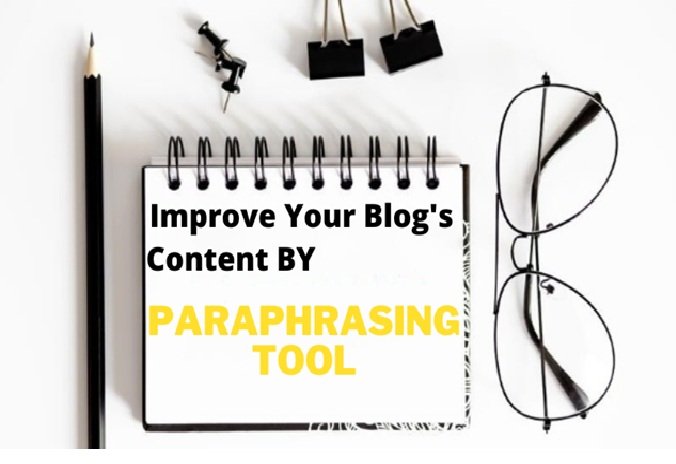MARKETING
How Can You Improve Your Blog’s Content with a Paraphrasing Tool?

Paraphrasing tools are getting extremely popular, especially among bloggers. The reason is that these tools allow them to rewrite some of the old stuff with very high accuracy.
Uniqueness is the most important factor that determines the search engine ranking of your website. Most search engines determine the worth of your site by looking at the content that you post.
This is why you need to make sure the material you write in your blog contains zero plagiarism. For this purpose, you can use paraphrasing tools. These tools allow you to come up with unique ideas, words, and phrases that you incorporate into your blog to increase readability as well as reader engagement.
What is a Paraphrasing Tool?
A paraphrasing tool can be used to generate new text to explain existing ideas, concepts, or themes. These tools take minutes to convert your old text into an entirely new form having new phrases, words, and synonyms while keeping the original theme intact.
These tools improve the readability, grammar, and other key aspects of your text to make it coherent and consistent. These tools use AI technology to make your content unique and to improve the tone, style, and other features.
There are many reasons to use these tools and in this next section we will take a look at some of these
1. Complete Analysis of Your Content
Before rephrasing your content, these tools analyze it completely to determine a few key things. These include word count, readability, spelling and grammar mistakes, and the main theme and tone of the content.
This complete analysis allows these tools to generate highly accurate content that you can post on your blog without fearing plagiarism.
These tools are very accurate when analyzing your content and that allows you to trust these completely to perform paraphrasing for you.
2. Changing Content Tone
The tone of your content is what separates it from others and engages your audience. Paraphrasing tools can rewrite your material while giving it a pleasant and consistent tone.
These tools can make adjustments that make your content easy to read, understand, and digest. By working on the tone of your text, these tools make it SEO-friendly which leads to better search engine ranking.
3. Better Content Flow
When writing content for your SEO or blogs, you need to make it seem like it’s connected and flowing in a consistent manner. Writing about different stuff randomly makes it seem all over the place which leaves a bad impression on your readers.
Paraphrasing tools can help you improve the flow of information that you provide in your content. This makes it more concise and understandable.
Some Ways in Which Paraphrasing Tools Can Improve Your Blogs
Paraphrasing tools are really a blessing for bloggers and general content writers. These tools save time and offer very high accuracy.
Here are some of the main ways in which such tools can help you write plagiarism-free blogs
1. Replacing Words with Synonyms
The main reason these tools are effective is that they offer a number of synonyms for every word in the content. You can use these tools to replace single words, phrases, sentences, or even paragraphs.
The paraphrase online turns your entire text into something new which makes it free from plagiarism of every type.
2. Improve Spellings and Grammar
Paraphrasing tools improve the grammatical errors and inconsistencies in your original text. These tools highlight lines that need to be changed and you can use some other tool to eliminate these errors.
These tools also identify and remove spelling mistakes as well. The final content that you get from these tools is immaculate in every way. It is consistent with the main theme and each sentence flows from the last one.

3. Save Time and Energy
Paraphrasing without a tool can take so much of your time and energy. You need to consult various sources to learn new words and ideas to incorporate into your text which is very time-consuming.
Paraphrasing tools help you save a lot of time by rewriting more than 1000 words in a matter of a few minutes. Doing this yourself can take several hours which you can spend on something more important.
4. Cost-Effective
Hiring content writers to write unique content for your blog is quite expensive. You have to spend a lot if you hire someone else to rewrite content for you and there is still no guarantee that the contest will be plagiarism-free.
You can find several free paraphrasing tools online to do that for you. These tools require no registration or login which means you can just go online and convert the text instantly.
5. Creative Writing
Most paraphrasing tools can help you write creative content. These tools take your words and phrases as prompts and use AI to write creative material that you can post on your blog.
This is especially helpful for a writer suffering from writer’s block. These tools can inspire them to look at things from a different perspective. This improves their skill as a writer and enhances the quality of their content.

Final Thoughts:
So, these are some of the few ways in which paraphrasing tools can help you improve the content of your blogs. These tools can help you write better material that has zero grammatical errors and is more engaging.
Without these tools, you will only be wasting your time and money with little to get in return. Paraphrasing tools are being used both by academic and non-academic persons who often find it hard to rewrite stuff due to having limited vocabulary and a grasp of grammar.
Now you know what are some of the major benefits of using paraphrasing tools when writing content for your blogs. These tools can lead to better content for your blogs that is both search engine friendly and engaging.
We hope this stuff helps and we suggest you to use these tools for improving your skills as a blog writer.



















You must be logged in to post a comment Login